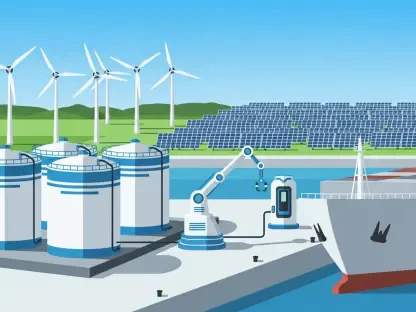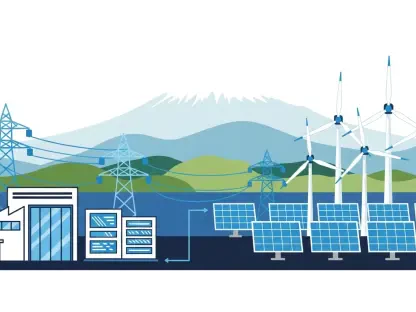What happens when a single, scarce metal stands between humanity and a clean energy future? Iridium, a rare and costly element, has long been a critical component in producing green hydrogen, a fuel hailed as the backbone of a net-zero world, but with global supply limited to just 7-8 tons annually, scaling this technology has seemed like an impossible dream. Enter VSPARTICLE, a company that, alongside Plug Power and the University of Delaware’s Center for Clean Hydrogen, has slashed iridium use by up to 90% in proton exchange membrane (PEM) electrolyzers. This isn’t just a technical tweak—it’s a seismic shift that could redefine sustainable energy.
The significance of this breakthrough cannot be overstated. Green hydrogen, produced by splitting water with renewable energy, offers a path to decarbonize industries from shipping to steelmaking. However, the dependency on iridium has kept costs prohibitively high, stalling progress. By reducing reliance on this precious metal, VSPARTICLE’s innovation promises to make green hydrogen economically viable, aligning with the U.S. Department of Energy’s ambitious “Hydrogen Shot” goal of $1 per kilogram. This development marks a turning point, potentially accelerating the global transition away from fossil fuels.
Why Green Hydrogen Matters in Today’s Energy Landscape
Green hydrogen stands as a cornerstone in the fight against climate change, offering a versatile, zero-emission fuel for hard-to-abate sectors. Unlike traditional hydrogen production, which relies on fossil fuels and emits significant carbon, green hydrogen uses renewable sources like wind and solar. This makes it a linchpin for achieving net-zero targets, especially in regions aiming to phase out coal and gas.
The challenge, however, lies in scaling production to meet soaring demand. Analysts predict that by 2030, global hydrogen needs could triple, driven by policies and corporate commitments to sustainability. PEM electrolyzers, prized for their ability to handle intermittent renewable energy, are central to this vision—but their iridium dependency has created a formidable barrier, both in cost and availability.
This is where the urgency of innovation comes into sharp focus. With iridium prices often exceeding $4,000 per ounce, the economics of green hydrogen have remained out of reach for widespread adoption. Solving this bottleneck isn’t just a technical hurdle; it’s a necessity to ensure clean energy becomes accessible to all, from industrial giants to developing economies.
Unpacking the Iridium Bottleneck in PEM Electrolysis
At the heart of PEM electrolyzers lies a critical flaw: their reliance on iridium, a metal rarer than gold or platinum. Essential for catalyzing the water-splitting reaction, iridium ensures efficiency and durability under harsh operating conditions. Yet, with traditional designs requiring 1-2 mg/cm² of this material per unit, the math quickly becomes unsustainable as production scales to gigawatt levels.
Global supply constraints exacerbate the issue. Mining just a handful of tons each year, mostly as a byproduct of platinum extraction, the iridium market cannot keep pace with the needs of a burgeoning hydrogen economy. This scarcity drives up costs, creating a vicious cycle where price volatility deters investment in large-scale projects.
Moreover, the environmental footprint of iridium extraction raises additional concerns. Often sourced from energy-intensive mining operations, the metal’s procurement clashes with the very sustainability goals green hydrogen seeks to achieve. Addressing this dependency is not merely an economic imperative but also an ethical one, pushing the industry toward alternative solutions.
VSPARTICLE’s Game-Changing Nanoporous Catalyst
VSPARTICLE has rewritten the rules of PEM electrolysis with a revolutionary nanoporous catalyst layer. Using a dry deposition technique known as spark ablation, the technology reduces iridium loading to a mere 0.1 mg/cm²—a 90% cut compared to conventional methods. This drastic reduction doesn’t compromise performance; instead, it enhances it through a uniform structure that maximizes electrochemical surface area.
The results speak for themselves. Data unveiled at the Electrochemical Society Meeting in Chicago revealed that these electrodes surpass the Department of Energy’s 2026 targets, achieving an operating voltage of 1.74 V at 3.0 A/cm². Even more impressive is the durability, with a degradation rate below 2.3 µV/h over 8,000 hours, translating to a 10-year lifespan for systems in real-world conditions.
Beyond efficiency, the design offers practical advantages. By eliminating PFAS-based ionomers and solvents, the production process becomes cleaner and more streamlined, while recycling becomes simpler. This innovation doesn’t just cut costs—it reimagines the entire manufacturing paradigm, setting a new standard for sustainable engineering in hydrogen technology.
Expert Endorsements Bolster the Breakthrough
Industry leaders and academics alike have rallied behind VSPARTICLE’s advancement, lending it credibility beyond lab results. Dr. Thomas Valdez of Plug Power highlighted the electrodes’ exceptional durability and high current density, describing them as “ready for commercial deployment.” His endorsement underscores the technology’s potential to meet the rigorous demands of real-world applications.
Dr. Yushan Yan from the Center for Clean Hydrogen at the University of Delaware offered a stark warning about the looming iridium supply crisis, noting that without such innovations, green hydrogen’s growth could stall indefinitely. He labeled this solution a “game-changer,” pointing to its role in reshaping the economics of clean fuel production for the better.
Adding to the chorus, Aaike van Vugt, CEO of VSPARTICLE, emphasized the scalability of the approach. “This technology achieves near-optimal iridium efficiency, paving the way for electrode manufacturing at an unprecedented scale,” he stated. Together, these voices paint a picture of a solution not just promising in theory, but poised for transformative impact across the sector.
Bridging the Gap from Lab to Global Impact
The journey from laboratory success to market dominance is already underway. VSPARTICLE is expanding its in-house coating capacity to support pilot projects with top PEM electrolyzer manufacturers, aiming for full commercial-scale testing by 2027. This timeline reflects a deliberate push to integrate the technology into multi-gigawatt production frameworks without the fear of material shortages.
The broader implications are equally compelling. With renewable electricity costs having dropped significantly in recent years, as reported by IRENA, the reduced iridium requirement positions green hydrogen to compete with fossil fuel-derived alternatives, currently priced at $1.50-$2.50 per kilogram. Meeting the DOE’s $1/kg target ahead of schedule could redefine energy markets, making clean hydrogen a mainstream option.
Additionally, the technology shows adaptability beyond PEM systems, with potential applications in anion exchange membrane (AEM) electrolysis. This versatility hints at a ripple effect, where a single innovation could influence multiple facets of hydrogen production, further solidifying its relevance in the evolving energy landscape.
Reflecting on this milestone, it’s clear that VSPARTICLE and its partners tackled one of the most daunting challenges in green hydrogen production with remarkable ingenuity. The drastic reduction in iridium use, paired with proven performance, marked a defining moment for the industry. Looking ahead, the focus shifts toward rapid adoption—industry stakeholders need to prioritize partnerships and investments to scale this technology. Policymakers must craft supportive frameworks to incentivize deployment, while engineers and innovators are tasked with exploring its broader applications. This breakthrough lays a foundation, but the next steps demand collective action to turn potential into a global reality.









